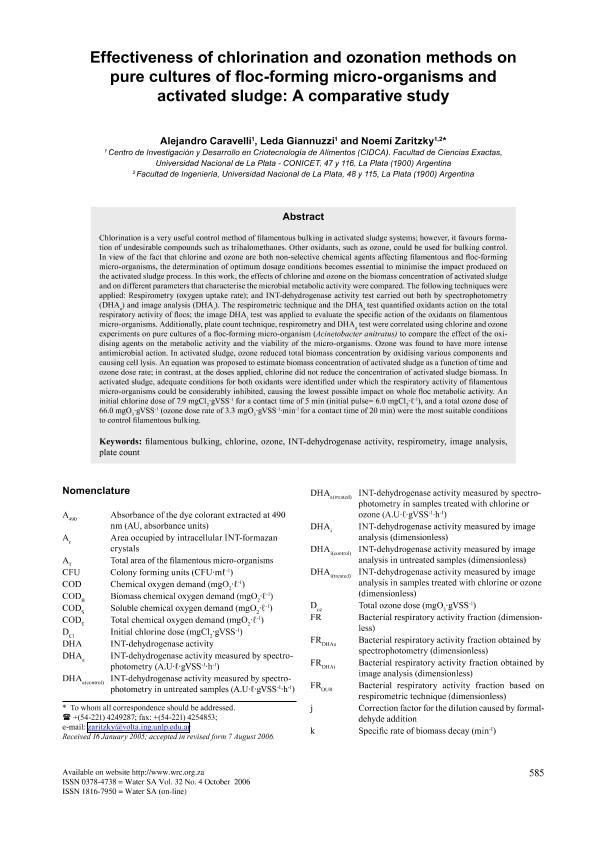Artículo
Effectiveness of chlorination and ozonation methods on pure cultures of floc-forming micro-organisms and activated sludge: A comparative study
Fecha de publicación:
12/2007
Editorial:
Water Research Commission
Revista:
Water S.a.
ISSN:
0378-4738
e-ISSN:
1816-7950
Idioma:
Inglés
Tipo de recurso:
Artículo publicado
Clasificación temática:
Resumen
Chlorination is a very useful control method of filamentous bulking in activated sludge systems; however, it favours formation of undesirable compounds such as trihalomethanes. Other oxidants, such as ozone, could be used for bulking control. In view of the fact that chlorine and ozone are both non-selective chemical agents affecting filamentous and floc-forming micro-organisms, the determination of optimum dosage conditions becomes essential to minimise the impact produced on the activated sludge process. In this work, the effects of chlorine and ozone on the biomass concentration of activated sludge and on different parameters that characterise the microbial metabolic activity were compared. The following techniques were applied: Respirometry (oxygen uptake rate); and INT-dehydrogenase activity test carried out both by spectrophotometry (DHAa) and image analysis (DHAi). The respirometric technique and the DHAa test quantified oxidants action on the total respiratory activity of flocs; the image DHAi test was applied to evaluate the specific action of the oxidants on filamentous micro-organisms. Additionally, plate count technique, respirometry and DHAa test were correlated using chlorine and ozone experiments on pure cultures of a floc-forming micro-organism (Acinetobacter anitratus) to compare the effect of the oxidising agents on the metabolic activity and the viability of the micro-organisms. Ozone was found to have more intense antimicrobial action. In activated sludge, ozone reduced total biomass concentration by oxidising various components and causing cell lysis. An equation was proposed to estimate biomass concentration of activated sludge as a function of time and ozone dose rate; in contrast, at the doses applied, chlorine did not reduce the concentration of activated sludge biomass. In activated sludge, adequate conditions for both oxidants were identified under which the respiratory activity of filamentous micro-organisms could be considerably inhibited, causing the lowest possible impact on whole floc metabolic activity. An initial chlorine dose of 7.9 mgCl2·gVSS-1 for a contact time of 5 min (initial pulse= 6.0 mgCl2·ℓ-1), and a total ozone dose of 66.0 mgO3·gVSS-1 (ozone dose rate of 3.3 mgO3·gVSS-1·min-1 for a contact time of 20 min) were the most suitable conditions to control filamentous bulking.
Archivos asociados
Licencia
Identificadores
Colecciones
Articulos(CIDCA)
Articulos de CENTRO DE INV EN CRIOTECNOLOGIA DE ALIMENTOS (I)
Articulos de CENTRO DE INV EN CRIOTECNOLOGIA DE ALIMENTOS (I)
Citación
Caravelli, Alejandro Horacio; Giannuzzi, Leda; Zaritzky, Noemi Elisabet; Effectiveness of chlorination and ozonation methods on pure cultures of floc-forming micro-organisms and activated sludge: A comparative study; Water Research Commission; Water S.a.; 32; 4; 12-2007; 585-595
Compartir
Altmétricas




